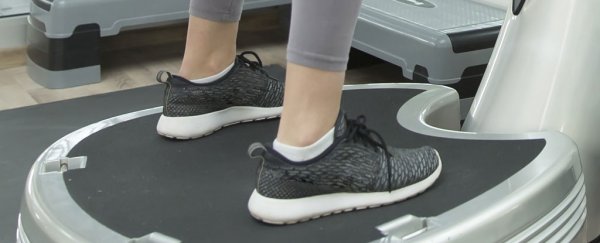Vibration platforms, belts, and accessories have been touted on late-night infomercials for decades as a simple, convenient alternative to actual exercise, but do they really work?
According to a recent study looking at the effects of whole body vibration on mice, yes, they actually do, by mimicking the benefits of exercise on muscle and bone health, and the researchers think the technique could help treat human health conditions too.
"Our study is the first to show that whole body vibration may be just as effective as exercise at combating some of the negative consequences of obesity and diabetes," says cellular biologist Meghan E. McGee-Lawrence from Augusta University.
McGee-Lawrence's team examined two groups of mice that took part in a 12-week health intervention. One of these groups consisted of healthy mice, while the other animals were diabetic and obese, due to being deficient in leptin receptors – meaning they couldn't sense fullness after eating.
Both groups were further broken down into three activity-based sub-groups: undergoing 20 minutes of whole body vibration a day, or 45 minutes on a treadmill daily. A third, sedentary sub-group did not perform any exercise during the 12-week experiment.
The idea behind whole body vibration is that when the platform you're standing on vibrates, the forced movement makes muscles repeatedly contract and relax, which in turn can release hormones that are good for the body – such as boosting osteocalcin, which enhances bone health.
"Every time you walk or run or stand on a vibrating platform, your bones are experiencing sheer stress and that sheer stress can change how those metabolically relevant hormones get released," explains one of the team, neuroscientist Alexis M. Stranahan.
In the study, the healthy mice didn't receive a significant benefit from the vibration training, but the obese and diabetic group exhibited the same metabolic benefits from both vibration and using the treadmill.
In comparison to sedentary obese mice, the obese group that took part in exercise or whole body vibration gained less weight, increased their muscle mass, reduced their insulin resistance, and improved their bone strength.
"We were not able to completely rescue the diabetic mice," McGee-Lawrence told Katherine Lindemann at ResearchGate.
"[T]hey were still heavier, with less bone and muscle than the healthy controls. But, we saw improvements in the diabetic mice treated with whole body vibration or exercise as compared to the sedentary diabetic mice."
The researchers admit that their study, which they acknowledge is preliminary research, needs to be tested further before we can know whether the same kinds of benefits would also apply to humans – and there's no guarantee that they will.
But they say that the results are nonetheless encouraging, and could suggest that whole body vibration may be able to play a beneficial role in easing obese people – who may not be able to exercise due to their weight – into very mild activity that could improve their health.
"If you are able to exercise, we'd still recommend exercise as a first choice option," McGee-Lawrence told Amanda MacMillan at Time, noting that the vibration settings of any equipment would play a big role in determining the outcome of the exercise proxy.
"The frequency and magnitude of the stimulus, and how long it's applied, need to be optimised to achieve the outcome you desire."
Other researchers are also warning people not to take the wrong conclusions away from this particular study.
While it might seem appealing to incur a benefit from passively standing and not needing to exert yourself, experts emphasise that if you can physically exercise, that's still your best bet.
"You can't compare the increases in strength and physical function, the weight loss that occurs with a well-designed exercise prescription, to what occurs when someone stands on a vibrating plate," physiologist Rob Newton from Edith Cowan University in Australia, who wasn't involved with the research, told AAP.
"Wouldn't you rather be out walking in the park, or lifting some weight while talking to your friends?"
The findings are reported in Endocrinology.
